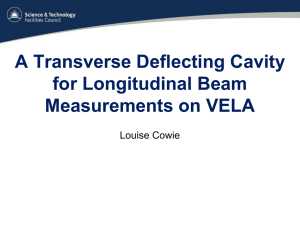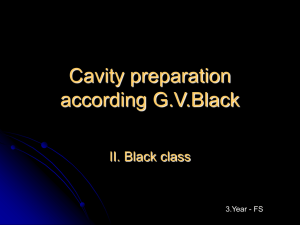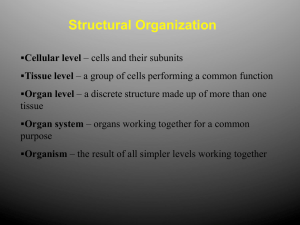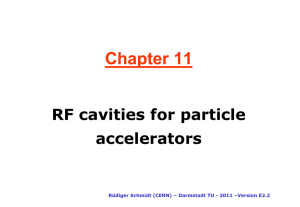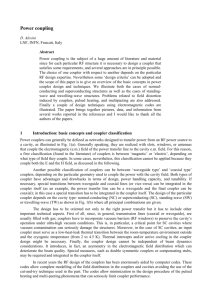synchronsiation
advertisement
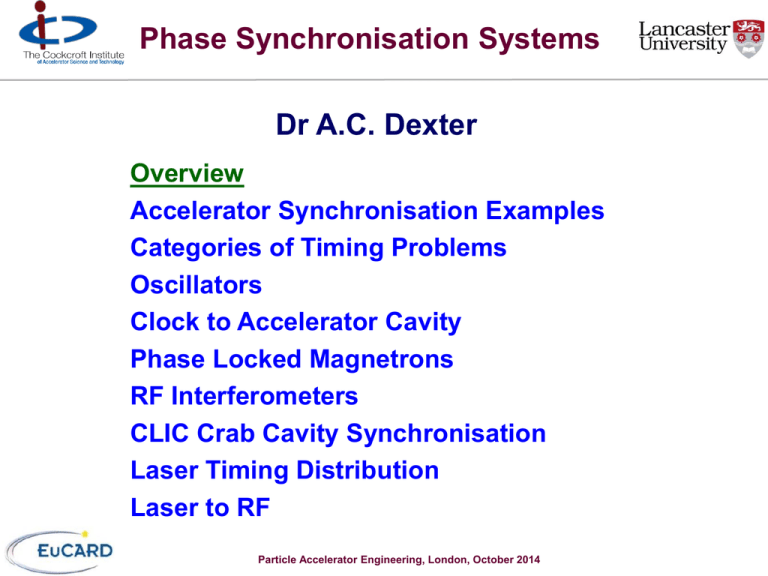
Phase Synchronisation Systems Dr A.C. Dexter Overview Accelerator Synchronisation Examples Categories of Timing Problems Oscillators Clock to Accelerator Cavity Phase Locked Magnetrons RF Interferometers CLIC Crab Cavity Synchronisation Laser Timing Distribution Laser to RF Particle Accelerator Engineering, London, October 2014 Accelerator Examples Bunch to RF Off crest acceleration Voltage gain as function of relative position Bunch position when RF field is maximum Free Electron Laser Crab Cavity System Electrons IP Positrons Crab cavity Crab cavity quadrupole quadrupole 25 m Particle Accelerator Engineering, London, October 2014 Categories of Timing Problems • Stability Oscillators shift period with temperature, vibration etc. Voltage Controlled Oscillator (VCO) shifts period with applied voltage Atomic clock Df/f ~ 10-14 ~ 60 fs per minute • Synchronisation Two clocks with different periods at same place (Phase Locked Loop) Identical delivery time/phase at two places (Crab Cavity Problem) Same clock at two places Resynchronisation requires constant propagation time of signal Detector with high resolution and low noise • Trigger an event at a later and a different location Needs two stable clocks which are synchronised (FEL problem) Must be able to generate event from clock pulse with tiny jitter Work at DESY and MIT suggest 10fs achievable Particle Accelerator Engineering, London, October 2014 Oscillators VCO or Magnetron Oscillator Oscillator using amplifier sensitive to temperature RF Output Filter RF Output Input and reflection on output port DC Input (changes frequency) reflection on output port DC Input (Changes phase) Phase Locked Loop (Synchronises oscillators at different frequencies, jitter follows performance of microwave oscillator and long term stability follows crystal oscillator) Crystal Oscillator Frequency divider /N Phase Detector Frequency divider /R Particle Accelerator Engineering, London 2014 Low Pass Filter / integrator Microwave Voltage Controller Oscillator Clock to Cavity LLRF control - feedforward to next pulse based on last pulse and environment measurements Optical clock signal Locked microwave oscillator Solid state amplifier IQ modulator Solid state amplifier TWT amplifier Waveguide Absolute timing impossible as every component and connector adds phase uncertainty Klystron Waveguide Pulse compressor Waveguide sensitive to temperature Cavity Extremely sensitive to modulator voltage Magnetron Exciting Superconducting Cavity Demonstration of CW 2.45 GHz magnetron driving a specially manufactured superconducting cavity in a vertical test facility at JLab and the control of phase in the presence of microphonics was successful. First demonstration and performance of an injection locked continuous wave magnetron to phase control a superconducting cavity A.C. Dexter, G. Burt, R. Carter, I. Tahir, H. Wang, K. Davis, and R. Rimmer, Physical Review Special Topics: Accelerators and Beams, Vol. 14, No. 3, 17.03.2011, p. 032001. http://journals.aps.org/prstab/abstract/10.1103/PhysRevSTAB.14.032001 Circuit for Phased Locked Operation Phase shifter Double Balance Mixer Spectrum Analyzer 2.45 GHz Panasonic 2M137 1.2 kW Magnetron Oscilloscope controls power Load 3 Phase shifter Stub Tuner 2 Loop Coupler 1W Amplifier Circulator 3 Stub Tuner 1 Circulator 2 Load 2 Loop Coupler Cathode heater control Load 1 IQ Modulator (Amplitude & phase shifter) DAC ADC DAC Digital Signal Processor Oscilloscope Digital Phase Detector HMC439 ÷2 Agilent E4428 signal generator providing 2.45 GHz ÷2 Unwanted 300 V DC +5% 120 Hz ripple LP Filter 8 kHz cut-off High Voltage Transformer 42 kHz Chopper Pulse Width Modulator SG 2525 1.2 kW Power Supply Control Voltage Sets current from modulator and can be in control loop to minimise phase change through magnetron, (or to source) Phase Control Performance 0 0 Injection but magnetron off Power spectral density (dB) -20 -30 Injection + magnetron on + control -10 Power spectral density (dB) -10 -40 -50 -60 -70 -80 -90 -100 -20 -30 -40 -50 -60 -70 -80 -90 -110 -120 -500 -250 0 Frequency offset (Hz) 250 500 Power spectral density (dB) Cavity phase error (degrees) 0 Injection + magnetron on -10 -20 -30 -40 -50 -60 -70 -80 -250 0 Frequency offset (Hz) 250 500 -250 0 Frequency offset (Hz) 250 500 45 Control on 35 Control off 25 15 5 -5 -15 0.00 -90 -100 -500 -100 -500 0.01 0.02 0.03 Time (seconds) 0.04 0.05 RF Interferometer Synchronisation when return pulse arrives at time when outward pulse is sent Position along cable Far location adjust effective position of far location with a phase shifter 180o 0o Near location time Interferometer line length adjustment synchronous output Precision reflector synchronous output digital phase detector digital phase detector loop loop filter filter coax link master oscillator phase shifter directional coupler directional coupler Phase shifter VTF Phase Control Tests IF Load Power meters Power meters phase detector board A DBM divide to 1.3 GHz synchronous reference signals Manual phase shifter Load cavity control 16 bit A/D DSP does IQ conversion then PI control vector mod. D/A Divider Load Loop filter phase shifter Phase shifter interferometer line length adjustment circuits phase detector board B divide to 1.3 GHz Manual phase shifter ~ 15 metre low loss (high power) coax link cavity control 16 bit A/D Load Rhode & Schwarz SG used to generate 3.9 GHz Manual Phase Shifter Load Phase shifter Loop filter DSP does IQ conversion then PI control D/A precision reflector circuit vector mod. Daresbury Test 2009 Period Jitter (degrees) 1 Cavity to cavity control off 10 secs 0.7942 2 Cavity to cavity control on 10 secs 0.0852 3 Cavity to cavity control on 0.05 secs 0.0743 4 Cavity to cavity no interferometer 10 secs 0.0888 5 Cavity to cavity no interferometer 0.05 secs 0.0763 6 Cavity to source 1 0.05 secs 0.0576 7 Cavity to source 1 10 secs 0.0600 CLIC Cavity Synchronisation CLIC bunches ~ 45 nm horizontal by 0.9 nm vertical size at IP. Cavity to Cavity Phase synchronisation requirement Target max. luminosity loss fraction S 0.98 f (GHz) 12.0 x (nm) 45 720 x f cc 1 S4rm s c (rads) frms (deg) 0.020 0.0188 1 degrees Dt (fs) Pulse Length (ms) 4.4 0.156 So need RF path lengths identical to better than c Dt = 1.3 microns RF path length measurement RF path length is continuously measured and adjusted 4kW 5ms pulsed 11.8 GHz Klystron repetition 5kHz Cavity coupler 0dB or -40dB Cavity coupler 0dB or -40dB Waveguide path length phase and amplitude measurement and control Forward power main pulse 12 MW -30 dB coupler -30 dB coupler Expansion joint Single moded copper plated Invar waveguide losses over 40m ~ 3dB Expansion joint Magic Tee LLRF Reflected power main pulse ~ 600 W LLRF Reflected power main pulse ~ 500 W Phase shifter trombone Phase shifter trombone (High power joint has been tested at SLAC) Main beam outward pick up Waveguide from high power Klystron to magic tee can be over moded Phase Shifter Main beam outward pick up From oscillator 48MW 200ns pulsed 11.994 GHz Klystron repetition 50Hz Control Vector modulation Particle Accelerator Engineering, London, October 2014 12 GHz Oscillator Laser Distribution Diagram from Florian Loehl, Cornell University Laser to RF j t VLF Loop filter The pulses sit on the zero-crossings of VCO output when it is locked. F(s) VCO f = f0 + KVLF j Balanced detector t Ti:sapphire ML-laser 2GHz phase modulator 100MHz Rep rate Diagram from J.W.Kim et al. MIT lRF/2 p/2


